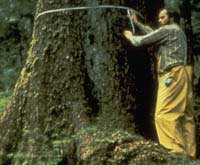
Long before the special-effects wizards made Stuart Little into a silver-screen sensation, E.B. White’s diminutive hero held a hallowed spot in a storytelling tradition that ranges from Gulliver’s Travels and “Jack and the Beanstalk” to Honey, I Shrunk the Kids. The basic idea: Make the workaday world utterly fantastic by changing the scale. Or, most everything looks cool when you’re only three inches tall.
Underlying these tales is a serious metaphor born of humankind’s historical swings between feast and famine. Note, for example, that during Gulliver’s stay in Lilliput, his prodigious appetite taxed the pint-size pantries of his hosts. Which leads us to an interesting question: Does Gulliver’s Travels deserve a spot on your bookshelf between Silent Spring and Desert Solitaire?

Or if not Jonathan Swift’s classic, what about the latest book by Tom Samaras, a self-made expert on human scale? Samaras, a configuration engineer who lives in San Diego, is the diligent and passionately earnest author of The Truth About Your Height: Exploring the Myths and Realities of Human Size and Its Effects on Performance, Health, Pollution, and Survival. The gist of the book: Tall guys might get the money, the power, and the sex, but they’re also more likely to run the planet into an early grave.
Samaras’s vision is enough to set the gladiator economy on edge. With the NBA playoffs underway and the NFL draft only recently behind us (the first round averaged 6 feet, 2 1/8 inches and 245.9 pounds), Samaras compels us to rethink our appetite for giants.
“Most people are just saying taller is good, that it reflects good health and good nutrition. But to me it’s insane to promote greater body size. For what purpose?” asks Samaras. “It’s just a cultural thing that we’ve been brainwashed about.”
This is perhaps not the best line of reasoning if you’re trying to make friends in a sports bar in Cleveland. But Samaras — whose sporting interests run more toward Olympic gymnastics than contests sanctioned by Beer Man and Louie the Lizard — insists we need to listen up. After all, he says his theory is based on one of the more inexorable laws of the galaxy, the second law of thermodynamics: “The entropy of a closed system shall never decrease, and shall increase whenever possible.” Paraphrased roughly: The bigger they come, the harder they fall.
Only the Big Die Young?
“I’ve always been in love with the concept of entropy,” says Samaras, who earlier in his career applied the theory to corporate America, hypothesizing that the more people and money in a company, the greater the corporate disorder.

Andre the Giant, dead at 47.
Next he applied his notions on entropy to the aging process, with the aid of an unlikely epidemiological database — the Baseball Encyclopedia. Comparing the height and the age of death of players, he found that for every extra inch, a player died an average of 1.2 years earlier.
If increased size penalizes the individual, what does it do to the species? “If humans are getting bigger, and we have been getting bigger for the last 150 years, what are the ramifications of this increasing body size?” asked Samaras. “It just seemed obvious to me that consumption tends to produce pollution, and bigger bodies tend to consume more.”
“Are you a big guy?” Samaras asks me in the middle of our phone interview. “I always feel defensive when I’m talking to big people.” Assured that I would be a poor prospect for the NBA, he continues.

Short people rule!
In this age of obscure scientific jousting over complex environmental issues such as climate change and endocrine disrupters, Samaras has a disarmingly simple argument: Six billion people weighing in at an average of 190 pounds would be equivalent to a population of 10.4 billion people weighing 110 pounds each. And that’s not a historically invalid comparison: Eighty years ago the average American male weighed 140 pounds. Now, in California, the average is 188 pounds. “We’re talking about 50 pounds more of biomass that produces pollution and requires resources,” says Samaras.
Samaras is clear that he thinks total population is the number one problem — that ultimately 6 billion matters more than six feet. Still, as he argues in his book, “the ecological benefits provided by a population of shorter, lighter people are unchallengeable. Shorter people require considerably less to live at the same general standard of living as taller people. They need less farm land, produce less rubbish, generate less air pollution, kill off fewer other life forms, and require much less water. While we focus our attention on population control, let’s not ignore the environmental benefits of keeping the size of people smaller than their maximum genetic potential.”
The Miller’s Tale
There are those who are unmoved by Samaras’s argument, even people who are not sports agents or market strategists for Nike.
“Let’s face it, everyone knows that big people do big things, including big environmental things,” says Rep. George Miller (D-Calif.), a green champion who stands “unofficially” between 6’3″ and 6’4″.

Big people fought for this big tree in the Tongass.
Photo: Alaska Rainforest Campaign.
“Congressman Mo Udall was a tall man when he protected the Alaska wilderness in the 1960s,” Miller says. “Congressman Phil Burton was a big man when he created the Golden Gate National Recreational Area in San Francisco in the 1970s. And I’m as big and tall now as I was when I protected the Tongass National Forest in the late 1980s. It’s true that sometimes I will order two entrees for dinner, exacerbating the demand for semolina, canned tomatoes, and garlic. But sometimes it takes big people to do big things, even to protect the environment.”
Bolstering Miller’s point is the fact that three of the stronger environmental legislators in the last few decades have been former NBA stars of not-insignificant stature: Udall, Bill Bradley, and Tom McMillen.
Nonetheless, Samaras insists we’re getting too big for more than just our britches.
“Right now we’re moving up,” he says. “The ideal height for a man is [seen as] 6’2″. If we reach that, then it will become 6’4″. Even if we didn’t do much about getting smaller but stabilized the growth and got away from this concept that bigger is better, we could save a lot in the future.”
And if we really work at it, we could feasibly shrink our frames toward the range of the Pygmies of the Congo — around four and a half feet in height — without damaging our cognitive potential, Samaras argues.
To truly downsize the species, we’d have to change our diet, specifically our children’s diet, he says. He cites one study that found kids from the ages of 2 to 10 get 25 percent more calories than they need. “Most people are actually overfeeding their kids,” says Samaras. (If you feel compelled to act on this theory, please consult your pediatrician before locking away the Cap’n Crunch.)
This plan may seem like radical dabbling with natural destiny, but Samaras argues that the tampering’s already been done. “The brave n
ew world has created this new being. It’s unnatural. We are eating in a way that, genetically, we have not ever been programmed to eat. We were programmed to be hunter gatherers and to eat when we could and to be very active. We are living the unnatural life.”
He has a point: Barring any undisclosed discoveries of the Human Genome Project, nobody has found the gene that inclines us to settle in with a box of Twinkies every time we tune in to the WWF (World Wrestling Federation, that is — not World Wildlife Fund). What the heck — perhaps it’s time to incorporate another direction into our obsessive cultural dialogues about body image. Read it and weep, supermodels and superjocks everywhere: Short is beautiful!
There’s only one catch: Somebody has to tell Shaquille O’Neal. I nominate Stuart Little for the job.

